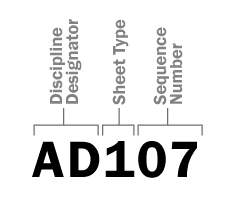Should Construction Form Rogs Continue With Set Numbers or Begin Their Own
Construction Document Sheet Numbers and Order
Many architecture offices have their own standards with regard to construction document sheet numbers and most architects are quite opinionated about whether the Structural drawings belong before or after the Architectural drawings. However, American clients sometimes demand that architects follow the United States National CAD Standard or the National BIM Standard - United States. The information below is adapted from and meets the US National CAD Standard.
We have a separate article for the AIA Contract Document numbers.
Components of the Sheet Number

There are three components that make up sheet numbers in a set of construction documents. The first two letters, thediscipline designators, identify the construction discipline that the sheet covers - architectural sheets, plumbing sheets, structural sheets, etc. The third digit, thesheet type, is a number that represents the type of drawings that are on the sheet - plans, sections, details, schedules, etc. The final two digits, thesequence numbers, are numbers that simply place the sheets in order.
Each component is explained in more detail below.
Discipline Designators

The discipline designator helps to identify the type of work that is included on the sheets. Since sheets are distributed to the different sub-contractors in the field, it is helpful for the drawings to be organized by discipline. Therefore, the plumbing contractor can easily take a set of "P" drawings, which has all of the plumbing drawings (plans, schedules, details, etc), and they will not have to sift through the unrelated electrical or structural drawings.
The discipline designator can be a single letter or a double-letter. Very large or complex projects will want to make use of the double-letter designations to help sub-divide each discipline further. For instance, on a complex hospital job with hundreds of sheets, it may be helpful to separate the electrical lighting drawings from the electrical power drawings. On a small residential project with a few dozen sheets, it is probably easy to have the lighting and power on the same sheet or sequential sheets.
The following table (from the U.S. National CAD Standard) indicates the primary (single) letter designations that may be used and the order that the disciplines should take. In this case, a hyphen shall be inserted in place of the secondary discipline designator so that the format remains. The second letter designators can be found in the US National CAD Standards.
| Designator | Name | Additional Description |
|---|---|---|
| Cover Sheet | ||
| G | General | Sheet list, symbols, code summary, etc. |
| H | Hazardous Materials | Abatement, handling, etc. |
| V | Survey / Mapping | |
| B | Geotechnical | |
| C | Civil | |
| L | Landscape | |
| S | Structural | |
| A | Architectural | |
| I | Interiors | |
| Q | Equipment | |
| F | Fire Protection | |
| P | Plumbing | |
| D | Process | |
| M | Mechanical | |
| E | Electrical | |
| W | Distributed Energy | |
| T | Telecommunications | |
| R | Resource | Existing conditions / buildings |
| X | Other Disciplines | |
| Z | Contractor / Shop Drawings | |
| O | Operations |
Sheet Types

The Sheet Types designator takes the drawings of a single discipline and organizes them. Drawings are always organized from most general to most specific or specialized. Since plans are most helpful to see the overall design of the project, they come first. Elevations and sections are a bit more specific and come next followed by details and schedules, which are the most specific type of drawings. The following table aligns with the U.S. National CAD Standard.
| Designator | Name |
|---|---|
| 0 | General: Symbol legend, abbreviations, general notes |
| 1 | Plans |
| 2 | Elevations |
| 3 | Sections |
| 4 | Large Scale Drawings: plans, elevations, sections (NOT details) |
| 5 | Details |
| 6 | Schedules and Diagrams |
| 7 | User Defined |
| 8 | User Defined |
| 9 | 3D drawings: isometric, perspective, photos |
Sequence Numbers

The final component of the sheet number is the two-digit sequence number, which is between 01 and 99. The sequence numbers do not have to be sequential so that space may be left within the set for future additions.
Example Sheet Numbers
| Number | Sheet Description |
|---|---|
| AD107 | Architectural Demolition Floor Plan, seventh sheet |
| A-204 | Architectural Elevations, fourth sheet |
| I-316 | Interior Section, sixteenth sheet |
| QH601 | Hospital Equipment Schedule, first sheet |
| FA601 | Fire Alarm Diagrams, first sheet |
| P-102 | Plumbing Floor Plan, second sheet |
| MH402 | Large Scale HVAC Drawings, second sheet |
| MP501 | HVAC Piping Details, first sheet |
| EP110 | Electrical Power Plan, tenth sheet |
| EL103 | Electrical Lighting Plan, third sheet |
| T-505 | Telecommunications Details, fifth sheet |
| RA102 | Architectural Existing Building Plan, second sheet |
Article Updated: November 8, 2020
Help make Archtoolbox better for everyone. If you found an error or out of date information in this article (even if it is just a minor typo), please let us know.
Source: https://www.archtoolbox.com/construction-document-sheet-numbers/
0 Response to "Should Construction Form Rogs Continue With Set Numbers or Begin Their Own"
Post a Comment